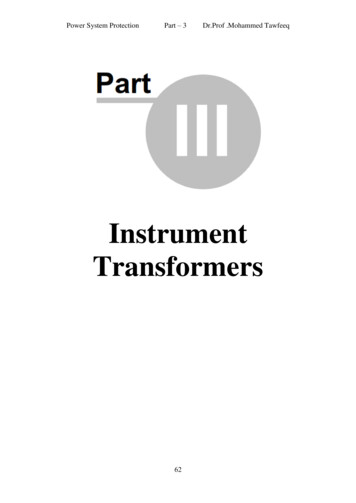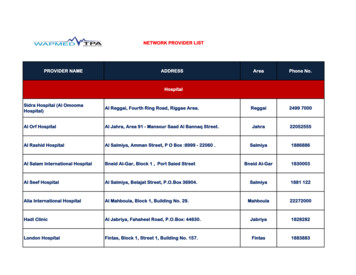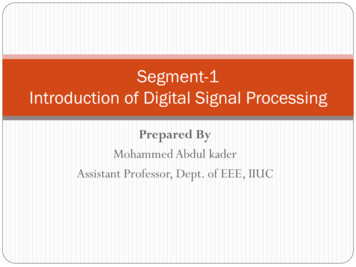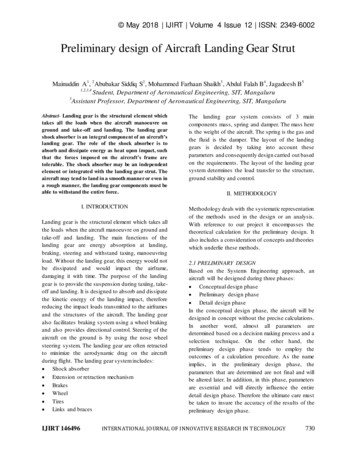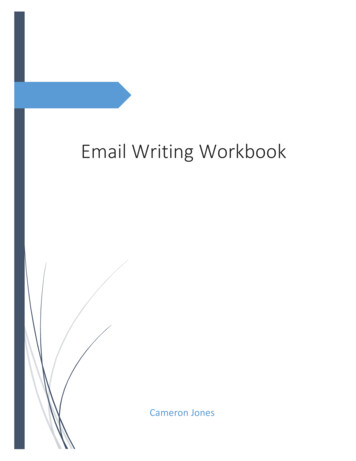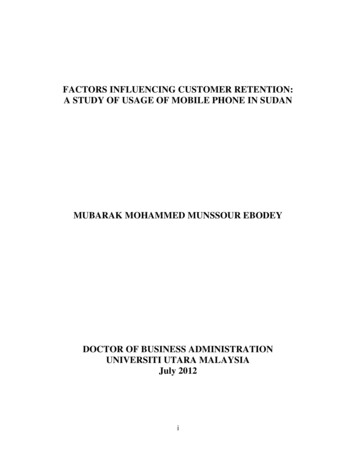
Transcription
FACTORS INFLUENCING CUSTOMER RETENTION:A STUDY OF USAGE OF MOBILE PHONE IN SUDANMUBARAK MOHAMMED MUNSSOUR EBODEYDOCTOR OF BUSINESS ADMINISTRATIONUNIVERSITI UTARA MALAYSIAJuly 2012i
FACTORS INFLUENCING CUSTOMER RETENTION:A STUDY OF USAGE OF MOBILE PHONE IN SUDANByMUBARAK MOHAMMED MUNSSOUR EBODEYDissertation Submitted toOthman Yeop Abdullah Graduate School of BusinessUniversiti Utara Malaysiain Partial Fulfillment of the Requirements for the Degree ofDoctoral of Business Administrationi
ii
iii
PERMISSION TO USEIn presenting this dissertation in partial fulfillment of the requirements for apostgraduate degree from Universiti Utara Malaysia, I agree that the UniversityLibrary make it freely available for inspection. I further agree that permission forcopying of this dissertation in any manner, in whole or in part, for scholarlypurpose may be granted by my supervisor or, in his absence by the Dean ofOthman Yeop Abdullah Graduate School of Business. It is understood that anycopying or publication or use of this dissertation or parts thereof for financial gainshall be given to me and to Universiti Utara Malaysia for any scholarly use whichmay be made of any material from my dissertation.Request for permission to copy or make other use of materials in this dissertation,in whole or in part should be addressed to:Dean of Othman Yeop Abdullah Graduate School of BusinessUniversiti Utara Malaysia06010 UUM SintokKedah Darul Amaniv
ABSTRACTWith the advancement in the telecommunication industry, mobile telecommunicationand use of other phone types in Sudan have gained impetus in the recent past. Thisadvancement in telecommunication technology in Sudan gained momentum in the year2005. Since then, many Sudanese have embraced the technology which shows thatcommunication technology is spreading rapidly in the country. At this very early stageof development, the industry hosts three major competitors giving the implication thatthe market is still green. Therefore, the company that employs the best strategies inensuring highest customer retention has an upper hand of gaining a competitiveadvantage in the market and thus reaping maximum profits from the industry. Beingoperational in a developing country, the companies have not done much to improvecustomer retention strategies in their mode of service delivery. If the key players wouldpay the attention of improving consumer retention strategies, they would improve theirservice delivery infrastructure which would affect the profitability of different serviceproviders differently depending on how consumer friendly their services are. This studyseeks to establish some of the fundamental factors that affect consumer retention byinvestigating the three major mobile telecommunication operators in Sudan. It willfocus on MTN Sudan, Sudatel and Zain Sudan (Mobitel). The study employsquantitative method by surveying university students. A discussion of the results of thisstudy will form the basis of recommendations for companies, academicians and otheroperators and stakeholders of the telecommunication industry in Sudan. The realizationthat customer retention is highly influenced by customer loyalty and behavior amongmany other factors will be explored in the context of the three companies mentionedhereinbefore. It will be evident that behavioral intentions directly rely on priceperceptions, perceived switching barriers and firms’ reputations.Key Words: Mobile Phone Telecommunication, Consumer Retention, CustomerLoyalty and Consumer Behavior.v
ABSTRAKDengan kemajuan industri telekomunikasi, telekomunikasi mudah alih dan penggunaanberbagai jenis kaedah comunikasi di Sudan telah mendapat dorongan sejakkini. DiSudan kemajuan dalam teknologi telekomunikasi ini telah mendapat momentum nyasejak tahun 2005. Sejak itu, ramai rakyat Sudan telah melibatkan diri denganperkembangan teknologi ini dan telah merebak dengan meluas. Pada peringkat awalpembangunan, industri ini telah mengundang tiga pesaing utama dan ini memberiimplikasi bahawa pasaran masih hijau. Oleh itu, syarikat yang menggunakan strategiterbaik dan boleh mengekalkan kepercayaan pengguna serta yang memuaskanpelanggan akan mempunyai peluang untuk mendapatkan kelebihan daya saing yangtinggi dalam pasaran dan seterusnya mengaut keuntungan maksimum dari perusahaanini. Syarikat yang menjalankan operasi di sebuah negara membangun, didapati kurangberusaha dari segi mengekalkan penggunaan di kalangan pelangang dalammengedalikan corak saluran perkhidmatan, keupayaan tidak dilakukan banyak untukmemperbaiki strategi pengekalan pelanggan dalam mod penyampaian perkhidmatanmereka. Jika pemain utama mengambil lebih perhatian terhadap memperbaiki strategipengekalan pengguna, mereka akan meningkatkan infrastruktur penyampaianperkhidmatan mereka.Mereka akan dapat lebih keuntungan dari pembekalperkhidmatan yang berbeza bergantung kepada bagaimana mesra penggunaperkhidmatan mereka. Kajian ini bertujuan untuk menubuhkan beberapa faktor asasyang mempengaruhi pengekalan pengguna dengan mengkaji tiga telekomunikasipengendali mudah alih utama di Sudan. Ia akan memberi tumpuan kepada MTN Sudan,Sudatel dan Zain Sudan (Mobitel). Kajian ini menggunakan kaedah kuantitatif ke ataspelajar universiti. Satu perbincangan hasil kajian ini akan membentuk asas cadanganuntuk syarikat, ahli akademik dan operator lain dan pihak berkepentingan industritelekomunikasi di Sudan. Kesedaran bahawa pengekalan pelanggan sangat dipengaruhioleh kesetiaan pelanggan dan tingkah laku di kalangan banyak faktor lain akanditerokai dalam konteks ketiga-tiga syarikat yang disebut terdahulu. Ia akan menjadijelas bahawa niat tingkah laku secara langsung bergantung kepada persepsi harga,halangan perubahan yang nyata dan reputasi firma.Katakunci: Telefon Telekomunikasi Mudah Alih, Penahanan Pengguna, KesetiaanPelanggan, Tingkah Laku Penggunavi
ACKNOWLEDGEMENTSAllah subhanahu wata’ala has set limits to the depth of sea and height of mountains butthere is no limit to success or perfection. Hence, as an author of this thesis, I cannotclaim perfection in all respects, but at the same time with all humility, I can assert that Imade all possible efforts to make it a successful one. All praise is due to Allah SWT,who made all things possible.My last remaining task is to acknowledge all those people that have contributed to thework described in this thesis. This is an impossible task, given the many people thathave helped to collect data, criticize, sponsor and finalize the work. I am going to tryanyway, and if your name is not listed, rest assured that my gratitude is not less than forthose listed below.I would like to acknowledge and extend my heartfelt gratitude to Prof. Dr. El ZubierBeshir Taha for his support and encouragement even before my arrival to Malaysia,during his tenure as The Minister of Science and Technology-Sudan. This is to registermy profound gratitude for all Prof. Dr. El Zubier has done for me. I have no doubt inmy mind that whatever I am today, or becomes in future is traceable to almighty Allahand to his exceptional characteristics and kindness. I do not have the words to thankhim enough, But to say the least, I say "Thank you very much".This dissertation would not have been possible without the help, support and patienceof my principal supervisor, Assoc. Prof. Dr. Hamzah, who is most responsible forhelping me complete the writing of this thesis as well as the challenging research thatlies behind it. Assoc. Prof. Dr. Hamzah has been a friend and mentor. I have beenfortunate with his supervision, he was always there to meet and talk about my ideas,and to ask me good questions to help me think through my problems. He, and all OYAmembers, Prof. Dr. Ruswati, Assoc. Prof. Dr. Nur Azila, Puan Zaidah, Puan Hamidah,my ideal lecturers Prof. Dr. Rosli, Prof. Dr. Juhary, Prof. Dr. Hassan, Assoc. Prof.Hartini, Assoc. Prof. Dr Barudin, Dr. Salniza, and Dr. Zulkifli, were all very funny, andwere more than anything fantastically normal and human. I thank them all.vii
DEDICATIONThis dissertation is dedicated to my family. Above all, I would like to thank mymother since during all my life she encouraged me always to reach out for the nexthigher level. I would not be on this path without her, then my wife Elshefa for herpersonal support and great patience at all times, then my brothers Mohammed, Taha,Imad, Abdulaziz, Badrudin, Mustafa and Ahmed, my sisters Weda’a, Safiah, Saeedah,Darusalam, Magam, Aisha, and Firdaous for giving me life in the first place, foreducating me, and for unconditional support and encouragement to pursue myinterests, even when the interests went beyond boundaries of language, field andgeography; without them life would be bleak. My parents, wife, brothers and sistershave given me their unequivocal support throughout, as always, for which my mereexpression of thanks likewise does not suffice.viii
TABLE OF CONTENTSCONTENTTITLE PAGECERTIFICATION OF DISSERTATION WORKPERMISSION TO USEABSTRACTABSTRAKACKNOWLEDGEMENTSDEDICATIONTABLE OF CONTENTSLIST OF TABLESLIST OF FIGURESLIST OF ABBREVIATIONSPageiiiivvviviiviiiixxivxvxviCHAPTER ONE: INTRODUCTION1.1. Background of the Study1.2 Contextual Background1.2.1 Telecommunication Sector in Developing Countries1.2.2 Sudan telecommunication sector1.3 Problem Statement1.4 Customer Satisfaction1.5 Relationship Marketing and Selling1.6 Research Questions (RQs)1.7 Research Objectives (ROs)1.7.1 Aim of the research1.7.2 Objectives of the research1.8. Research Justification1.9. Significance of the study1.9.2. Academics Level1.9.3. Practitioner Level1.10. Scope of the Study1.11. Organization of the research13347111114151515161819202222CHAPTER TWO: LITERATURE REVIEW2.1. Introduction2.2 Population Composition and Consumption2.3 Economic Status and Consumption2.4 Regulations and Consumer Protection2.5 Availability of Goods and Services2.6 Market Coverage by Service Providers2.7 Market Share2.7.1 Mobile Telephone Network (MTN)2.7.2 Zainix242425303233353535
2.7.3 Sudatel2.8 Culture and Cellphone Usage2.9 Customer retention strategies2.9.1 Profitability2.9.2 Lifetime Value2.9.3 Segmentation2.9.4 Customer affinity2.9.5 Target Marketing2.9.6 Cross-selling2.9.7 Campaign Analysis2.10 Customer Retention2.11 Customer Loyalty2.12 Behavioral Intention2.13 Price Perception2.14 Switching Costs2.15 Firm Reputation2.16. Path/Framework2.16.1. Price Perception and Customer Loyalty2.16.2. Price Perceptions and Behavioral Intentions2.16.3. Switching Barriers and Behavioral intention2.16.4. Switching Barriers and Customer Loyalty2.16.5. Corporate Reputation and Customers’ Behavioral Intentions2.16.6. Corporate Reputation and Customer Loyalty2.16.7. Behavioral Intentions and Customer Retention2.16.8. Customer Loyalty and Customer Retention2.16.9. The mediating role of Customer loyalty between price perceptionand customer retention2.16.10. The mediating role of Customer loyalty between firm reputationand customer retention2.16.11. The mediating role of Customer loyalty between perceivedswitching barrier and customer retention2.16.12. The mediating role of Behavioral intention between priceperception and consumer retention2.16.13. The mediating role of Behavioral intention between firmreputation and consumer retention2.16.14. The mediating role of Behavioral intention between perceivedswitching barrier and consumer retention2.17 Chapter 567707172757880818284CHAPTER THREE: RESEARCH METHODOLOGY3.1. Introduction3.2 Research Framework3.3 Hypotheses Development858687x
3.3.1 Theoretical Foundation3.3.2 Model Development and Research Hypotheses3.3.3 Research Variables3.3.3.1 Customer Loyalty and Price Perceptions3.3.3.2 Perceived Switching Barrier and Customer Loyalty3.3.3.3 Corporate Reputation and Customer Loyalty3.3.3.4 Consumer Retention and Customer Loyalty3.3.3.5 Price Perception and Behavioral intention3.3.3.6 Behavioral Intention and Perceived Switching Barrier3.3.3.7 Firm Reputation and Behavioral Intention3.3.3.8 Behavioral Intention and Consumer Retention3.3.4 Summary of Model Hypotheses3.3.5 Operational Definition of Key Variables3.3.6 Questionnaire Items3.4 Research Design3.5 Quantitative Approach3.6 Measurement of Variables/Instrumentation3.6.1 Questionnaires3.6.1.1 Questionnaires Design3.6.1.2 General Information3.6.1.3 Factors influence customer retention among Sudanesephone users.3.7 Data Collection and sampling3.7.1 Data Collection Procedures3.7.2 Sampling3.7.3 Sample Frame3.7.4 Sample Size determination3.7.5 Data Collection Method3.8 Chapter SummaryCHAPTER FOUR: DATA ANALYSIS AND RESULTS4.1. Introduction4.2 Obtained Data4.2.1 Data Screening4.2.2 Missing Data4.2.3 Overall Response Rate4.2.4 Response Bias4.2.5 Non-response Bias Test4.1.1 Respondents General Information4.3 Analyses of data4.3.1 Reliability Test (Cronbach’s Alpha)4.3.2 Exploratory Factor Analysis (EFA)4.3.3 Kaiser-Meyer-Olkin Test (KMO)4.3.4 Barlett’s Test of 113113114116116117118118
4.3.5 Normality Test4.3.6 Validity Test4.3.7 Factor Analysis of the Variables4.3.7.1 Construct One: Customer Retention4.3.7.2 Construct Two: Customer Loyalty4.3.7.3 Construct Three: Perceived Price4.3.7.4 Construct 4: Firm Reputation4.3.7.5 Construct Six: Switching Barriers4.4 Hypothesis Testing4.4.1 Customer Loyalty4.4.2 Firm reputation4.4.3 Price Perception4.4.4 Perceived Switching Barrier4.4.5 Behavioral intention4.4.6 Customer Retention4.5 Impact of Variables4.6 Relationship between Variables4.6.1 Relationship between Customer Retention on one hand and CustomerLoyalty and Behavioral Intention on the other4.6.1.1 Relationship between Customer Retention and CustomerLoyalty4.6.1.2 Relationship between customer retention and behavioralintention4.6.2 Relationship between Customer Loyalty on one hand and SwitchingBarriers, Firm reputation and Price Perception on the other4.6.2.1 Relationship between customer loyalty and price perception4.6.2.2 Relationship between customer loyalty and firm reputation4.6.2.3 Relationship between customer loyalty and switchingbarrier4.6.3 Relationship between behavioral intention on one hand and switchingbarrier, firm reputation and price perception the other4.6.3.1 Relationship between customer behavioral intention andprice perception4.6.3.2 Relationship between behavioral intention and firmreputation4.6.3.3 Relationship between behavioral intention and switchingbarriers4.6.4 Testing the Meditating Effect of Customer Loyalty4.6.4.1 Meditating Effect of Customer Loyalty between CustomerRetention and firm reputation4.6.4.2 Meditating Effect of Customer Loyalty between CustomerRetention and switching barrier4.6.4.3 Meditating Effect of Customer Loyalty between CustomerRetention and price perception4.6.5 Meditating Effect of Behavioral Intention between 8160160161
Retention on one hand and switching barrier, firm reputation andprice perception on the other4.7Summary of the Research Findings4.7.1 Model and Hypothesis Test4.7.1.1 Hypothesis 14.7.1.2 Hypothesis 24.7.1.3 Hypothesis 34.7.1.4 Hypothesis 44.7.1.5 Hypothesis 54.7.1.6 Hypothesis 64.7.1.7 Hypothesis 74.7.1.8 Hypothesis 84.8 Chapter Summary164166167168168169169170171172173CHAPTER FIVE: CONCLUSIONS & RECOMMENDATIONS5.1. Introduction5.2. Discussion of Results5.3 Contributions5.3.1 Theoretical Contributions5.3.2 Practical Contributions5.4 Limitations5.5 Recommendations5.6 ConclusionREFERENCESAppendicesAppendix A: QuestionnaireAppendix B: Questionnaire ScoresAppendix C: Selected analysis of 00
LIST OF TABLESTableTable 3.1 Summary of Model HypothesesTable 3.2 Operational Definition of Key VariablesTable 3.3 Questionnaire items and their sourcesTable 3.4 Questionnaire five pointsTable 3.5 Sample Size determinationTable 4.1 Demographic trendsTable 4.2 Internal Consistency ReliabilityTable 4.3 KMO TestTable 4.4 Bartlett's TestTable 4.5 Composite ReliabilityTable 4.6 KMO and Bartlett's Test of all the constructsTable 4.7 Factor analysis result for Perceived price, Switching barriers and firmreputation dataTable 4.8 KMO and Bartlett's Test for Perceived price, Switching barriers and firmreputationTable 4.9: Factor analysis result for Customer Loyalty, Behavioral Intentions dataTable 4.10 Descriptive Summary for Construct 1Table 4.11 Descriptive Summary for Construct 2Table 4.12 Descriptive Summary for Construct 3Table 4.13 Descriptive Summary for Construct 4Table 4.14 Descriptive Summary for Construct 5Table 4.15 OLS: Loyalty and behavioral intention with Customer Retention as dependentvariableTable 4.16 Summary Statistics: Customer Loyalty and Customer Retention andbehavioral intentionTable 4.17 OLS: Perceived Switching barrier, Firm Reputation and Price perception withCustomer loyalty as dependent variableTable 4.18 Summary Statistics: Customer Loyalty and Customer Retention andbehavioral intentionTable 4.19 OLS: Perceived Switching barrier, Firm Reputation and Price perception withBehavioral intention as dependent variableTable 4.20 Summary Statistics: Firm Reputation, Price Perception, Switching Barriers,and behavioral intentionTable 4.21 OLS: Perceived Switching barrier, Firm Reputation, Price perception andCustomer loyalty with Customer retention as dependent variableTable 4.22 OLS: Perceived Switching barrier, Firm Reputation and Price perception withCustomer retention as dependent variableTable 4.23 OLS: Perceived Switching barrier, Firm Reputation, Price perception andbehavioral intention with Customer retention as dependent variableTable 4.24 Summary of 123124125126127128144145148149152152157158162165
LIST OF FIGURESFigureFigure 1.1 Organization of the ResearchFigure 2.1 The Map of Sudan before and after SeparationFigure 2.2 Business Intelligence Model for customer retention processFigure 2.3 Path analysis framework for the current studyFigure 3.1 Conceptual Models for Consumer Retention in the TelecommunicationIndustryFigure 4.1 Behavioral intention customer retention scores graphFigure 4.2 Mediator effect methodFigure 4.3 Customer Loyalty as a mediator between Firm Reputation and CustomerRetentionxvPage2327395389148156159
LIST OF ABBREVIATIONSA.1- A.5: Customer loyalty items 1-5B.1- B.3: Firm Reputation items 1-3C.1-C.3: Perceived Price items 1-3D.1- D.5: Behavioural Intention items 1-5S.1- S.5: Switching Barriers items 1-5F.1- F.4: Customer Retebtion items 1-4Behint: Behavioral Intention variableReten: Customer Retention variableSwbar: Perceived Switch Barrier variablePrpercp: Perceived Price variableVar 00001 C.L: Customer loyaltyVar 00002 F.R: Firm ReputationVar 00003 P.S.P: Perceived Switch BarrierVar 00004 B.I: Behavioral IntentionVar 00005 P.P: Perceived Pricexvi
CHAPTER ONEINTRODUCTION1.1.Background of the StudyThe global telecommunication industry has experienced massive growth in therecent past thanks to rapid technological advancement that has improved thecommunication infrastructure. Rapid developments in the telecommunication industryhave led to major structural and managerial changes in the business world. This hasbeen contributed to by scientific discoveries and innovations which bring newadvanced technologies in the communication industry almost daily. This has led toglobalization and increased global economic activity.Technological advancements have led to increased competition in thecommunication industry. Consequently, companies in this field have been forced toadopt new policies and strategies to survive the competition. Customer managementand service markets have received increased interest in terms of relational aspects(Gronroos, 1990; Lawrence & Francis, 2005).Good customer relation is a vitalfactor as a tool for customer retention. This aspect is also very crucial for anorganization that seeks to have a loyal customer base and hence overcome the stiffcompetition in the industry (Berry, 1995; Morgan & Hunt, 1995, Manning, 2000;Christopher et al; Bitner, 1992).In the business world in general, several studies that have been conducted toinvestigate the relationship between customer retention and organizational growth1
The contents ofthe thesis is forinternal useronly
REFERENCESAhmad, J. & Buttle, T. (2002). The impact of customer satisfaction in marketing. London:Routledge.Alexandris, K., Dimitriadis, N., & Markata, D. (2002). Can perceptions of service qualitypredict behavioral intentions? an exploratory study in the hotel sector in Greece.Managing Service Quality, 12 (4), 224 – 231.Alford, B. L., & Biswas, A. (2002). The effects of discount level, price consciousness andsale proneness on consumers’ price perception and behavioral intention. Journal ofBusiness, 55 (9), 775-783.Ambrose, W., Paul, H., & Jean P. (1990). Privatizing telecommunications systems: businessopportunities in developing countries. IFC Discussion Paper: Wahington, DC.Anderson, W. E., & Mittal, V. (2000). Strengthening the satisfaction-profit chain. Journal ofService Research, 3, 107-120.Anuwichanont, J. (2011). The impact of price perception on customer loyalty in the airlinecontext. The 2011 Barcelona European Academic Conference Barcelona, Spain.Arab Advisors Group (2007). Sudan communications projections, Retrieved ab Advisors Group (2009). Sudan communications projections report. Retrieved sael, H., & Lipstein, B. (1978). How to reallocate marketing resources based on marketresponse. 24th annual meeting of the advertising research foundation, New York.Bansal, H. S., Irving, G. P., & Taylor, S. F. (2004). A three-component model of customer.Baron, R.M. & Kenny D.A. (1986). The moderator-mediator variable distinction in socialpsychological research: Conceptual, strategic, and statistical considerations. Journal ofPersonality & Social Psychology, 51, 1173-1182Berry, D. (1995). Special issue on telecommunication and management. MIS Quarterly,29(2), 193-195.Bolton, R. (1998). A dynamic model of the duration of the customer’s relationship serviceprovider: The role of satisfaction. Journal of Marketing Science, 17, 45-65.Boonton, F. (2005). Mobile Telecommunication. New York: Penguin.Bourreau, M., & Dogan, P. (2001). Regulation and innovation in the telecommunicationsindustry, Telecommunications Policy, 25,167-184.Bowen, J. T. & Chen, S. L. (2001). The relationship between customer loyalty and customersatisfaction. International Journal of Contemporary Hospitality Management, 13(4/5), 213-217.Bromley, D. B. (2000). Psychological aspects of corporate identity, image and reputation.Corporate Reputation Review, 3, 240–252.Burnham, T. A., Frels, J. K. & Mahajan, V. (2003). Consumer switching costs: a topology,antecedent and consequences. Journal of the Academy of Marketing Science, 32(2),213-217.Capozzi, L. (2005). Corporate reputation: our role in sustaining and building a valuableasset. Journal of Advertising Research, 45(3), 290 293.188
Chaudhuri, A., & Holbrook, M.B. (2002). Product-class effects on brand commitment andBrand outcomes: The role of brand trust and brand affect. Journal of BrandManagement, 10 (1), 33-58.Chen, P.Y. & Hitt, L. M. (2002). Measuring switching costs and the determinants ofcustomer retention in Internet-enabled businesses: A study of the online brokerageindustry. Information Systems Research, 13, 255–274.Christopher, M., Payne, A. & Ballantyne, D. (1992) Relationship Marketing-BringingQuality Customer Service and Marketing together, Oxford: Butterworth-HeinemannChristopher, G., David, C., Mike., C. & Esther, C. (2006) . A survey of customer retentionin the new zealand banking industry. Banks and Bank Systems, 1(4), 83-99.Cooil, B., Keiningham, T., Aksoy, L., & Hsu, M. (2007). Customer satisfaction and share ofwallet. Journal of Marketing, 71, 67-83.Coyles, S., & Gokey, T. (2005). Customer retention is not enough. Journal of ConsumerMarketing, 22, 101-105.Creswell, J.W. (2003). Research design. Qualitative, quantitative and mixed methodsapproaches. Thousand Oaks, CA: Sage.Creswell, J.W. (2009). Research design: Qualitative, quantitative, and mixed methodapproaches. CA: Sage.Cretu, A. E. & Brodie, R. J. (2007). The influence of brand image and company reputationwhere manufacturers market to small firms: a customer value perspective. IndustrialMarketing Management, 36 (2), 230 240.Davies, G., Chun, R., da Silva, R.J.V., & Roper, S. (2002). Corporate reputation andcompetitiveness. London: Routledge.DeSouza, D. (1992). Customer Satisfaction: Factors that affect Retention. London:Palgrave Macmillan.Diamante, V. (2003). Survey research: the basics. London: Sage Publications.Dick, A.S., & Basu, K. (1994). A customer loyalty: Toward an integrated conceptualframework. Journal of Academy of Marketing Science, 22, 99-113.Dodds, W.B., Monroe, K.B. & Grewal, D. 1991. The effect of price, brand and storeinformation on buyers‟ product evaluations. Journal of Marketing Research, 18, 3950.Dwyer, F. P., Schurr, H., & Sejo, O. (1987). Developing buyer seller relationships. Journalof Marketing, 51, 11–27.Eberl, M. & Schwaiger, M. (2005). Corporate reputation: disentangling the effects onfinancial performance. European Journal of Marketing, 39, 838–854.Egan, J. (2004). Relationship Marketing: Exploring Relational Strategies in Marketing.London: Prentice Hall.Foxall, G. (1984). Corporate innovation: marketing and strategy. New York: St Martin’sPress.Gale, H. (1997). Satisfaction is not enough. Journal of Marketing News, 18.Gerpott, T., Rams, W. & Schindler, A. (2001). Customer retention, loyalty, and satisfactionin the German mobile cellular telecommunications market. Telecommunication Policy,25 (4), 249–269.Gliner, J., & Morgan, G. (2000). Research methods in applied settings: An integratedapproach to design and analysis. London: Lawrence Erlbaum Associates.189
Gordon, I. (1999). Relationship Marketing: New strategies, techniques and technologies towin the customers you want and keep them forever. New York: John Wiley and SonsPublishers.Gronroos, K. (1990). Telecommunication Industry–Building Blocks for Success. Chichester:Wiley.Gummeson, P. (1999). Integrated Models for Profitability. San Francisco: WileyHart, C. W., & Johnson, M. D. (1999). Growing the trust relationship. MarketingManagement, Spring, 8-19.Hassan, F.E. (2011, February 08). North, south Sudan relationship enters new phase s.xinhuanet.com/english2010/world/2011-02/08/c 13722045.htmHawkins, D. I., Roger J. B., & Kenneth A. C. (1983). Consumer Behavior: Implications forMarketing Strategy. Plano, TX: Business Publications.He, Y., Cheung, S. & Tse, S. (2009). The role of switching costs on service loyalty: acanonical correlation analysis. Journal of Chinese Entrepreneurship, 1 (2), 154 – 164.Hennig-Thurau, F. & Klee, H. (1997). Telecommunications: The Approaches that havemade it Phenomenon. Minnesota: Univ Of Minnesota PressHennig-Thurau, T., & Klee, A. (1997). The impact of customer satisfaction and relationshipquality on customer retention: A critical reassessment and model development.Journal of Psychology and Marketing, 14.Hohnen, Paul (2007). Corporate social responsibility: An implementation guide forbusiness. Manitoba, Canada, International Institute for Sustainable DevelopmentHolbrook, M. B. (1994). The nature of customer value: an anthology of services in theconsumption experience. In R. T. Rust and R. L. Oliver (Eds.). Service Quality: NewDirections in Theory and Practice, 21-71.Jacoby, J., & Chestnut, R.W. (1978). Brand loyalty measurement and management. NewYork: Wiley.Jiang, P. & Rosenbloom, B. (2005). Customer intention to return online: price perception,attribute-level performance, and satisfaction unfolding over time. European Journal ofMarketing, 39 (1/2), 150-174.Jobber, D. (2001). Principles and practices of marketing. Maidenhead: McGraw- Hill.Jones, G. H., Jones, B.H. & Little, P. (2000). Reputation as reservoir: buffering against lossin times of economic crisis. Corporate Reputation Review, 3, 21–29.Jones, M. A., Mothersbaugh, D. L. & Beatty, S. E. (2000). Switching barriers andrepurchase intentions in services. Journal of Retailing, 76, 259–274.Jones, O. T., & Sasser, W, E. (1995). Why satisfied customers defect? Harvard BusinessReview, November-December, 88-99.Kaiser. (1974). Unrestricted versus restricted factor analysis of multidimensional test items:some aspects of the problem and some suggestions. spain.Kalwani, M. U. & Silk, A. (1982). On the reliability and predictive validity of purchaseintention measures. Journal of Marketing Science, 1, 243-286.Kanungo, R. N., & Pang, S. (1973). Effects of human models on perceived product quality.Journal of Applied Psychology, 57, 172-178.Katrichis, J. M. (1998). Exploring departmental level interaction patterns in organizationalpurchasing decisions. Industrial Marketing Management, 27 (2), 135 146.190
Keaveney, S. M. & Parthasarathy, M. (2001). Customer switching behavior in onlineservices: an exploratory study of the role of selected attitudinal, behavior, anddemographic factors. Journal of Academy of Marketing Science, 29 (4), 374-390.Keh, H. & Xie, Y. (2009). Corporate reputation and customer behavioral intentions: Theroles of trust, identification and commitment. Industrial Marketing Management, 38,732–742.Keiningham, T., Cooil, B., Aksoy, L., Andreassen, T. & Weiner, J. (2007). The value ofdifferent customer satisfaction and loyalty metrics in predicting customer retention,recommendation, and share-of-wallet. Managing Service Quality, 17 (4), 361 – 384.Keller, L.K. (1998). Strategic Brand Management. Upper Saddle River, NJ: P
2.9 Customer retention strategies 37 2.9.1 Profitability 39 2.9.2 Lifetime Value 40 2.9.3 Segmentation 40 2.9.4 Customer affinity 40 2.9.5 Target Marketing 41 2.9.6 Cross-selling 41 2.9.7 Campaign Analysis 41 2.10 Customer Retention 42 2.11 Customer Loyalty
